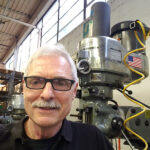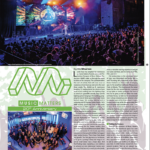When partners Chris Kennedy and George McDuff were thinking about what to call their new lighting control company in the early 2000s, they settled on ChamSys, standing for “Chameleon Systems.”
Like the chameleon, with its near 360-degree vision, the ability to see a wide range of opportunities has also characterized ChamSys throughout its history, from the company’s early embrace of networking, to its decision to expand its base by offering free PC- and Mac-based software, to its recent move to become part of the Chauvet family of brands.
“From the very beginning, our business model has been based on recognizing the needs of lighting designers and working on new ways that we can address those needs more effectively,” says Kennedy. Understanding lighting designers comes naturally to Kennedy since, like most of the engineers at ChamSys, he has operated shows himself.
In fact, it was through his work as a designer that Kennedy first met McDuff at London’s iconic Round House. “I was working as a lighting designer at a corporate event, and George was at the Round House supplying electronics for some entertainment machines,” recalled Kennedy. “I’d been working in telecoms and as a lighting designer and had developed a PC-based lighting control system that output via a DMX card/dongle. George had been involved in developing hardware for a number of lighting products, including dimmers, lighting controllers and laser controllers.” The two men shared an ambition to develop an affordable touchscreen lighting controller.
A Console is Launched
In March 2003, their vision became a reality with the introduction of their first console, the MagicQ MQ100. A major selling point was its central large color touchscreen surrounded by eight encoder wheels — handy in a world where fixtures were gaining more and more parameters. In addition, at a time when most consoles used floppy disks or CDs for show storage, the MQ100 went straight for USB storage.
Another feature of the first MagicQ consoles (something that has characterized all of its successors as well) was that it output Art-Net. “We expected that networking would be rapidly embraced, so we didn’t provide onboard DMX on our earliest consoles,” says Kennedy. “Instead we offered an external Art-Net to DMX conversion interface. However, it soon became apparent that the market was not ready to leave the world of DMX, so we quickly added onboard DMX on the MagicQ range.”
Still, the early farsighted adoption of networking allowed ChamSys to take a leadership position in network connectivity, remote access, remote control and networking protocol support. This, along with the company’s groundbreaking work in reducing the size of consoles, helped it develop a cult-like following among young, tech-savvy designers and programmers.
“We were lucky, as the MQ100 was pretty much an instant success,” says Kennedy. “We took a booth at PLASA London in 2004 on the upstairs balcony, and we came back with 10 distributors.”
ChamSys stood out, says Kennedy, because of its new ideas — for example, it allowed control of a media server through selection from a library of thumbnail images on the touchscreen, while other products were requiring users to adjust encoder wheels to select images.
ChamSys pioneered the way with its $15 MagicDMX interface, which, together with its free MagicQ software, enables users to get into lighting control of a complete universe of real DMX fixtures. This low entry cost helped to build up its huge base of regular users.
Expanding the Territory
The 10 distributors that signed on with ChamSys at the company’s first PLASA show were largely based in continental Europe. It would take a few more years for Kennedy and McDuff to penetrate their home U.K. market. Growth in the U.S. market came later still. With its controllers starting to appear at more concerts and festivals in North America, the company launched ChamSys USA in 2012. Phil Watson, a British LD who had been living and working in the U.S. for over two decades, was tapped to head the new venture.
As a designer, Watson had been a longtime ChamSys user. Typical of LDs in that group, his passion for ChamSys is palpable. “I have been using ChamSys for over 10 years,” he says. “As a designer, I wanted three things from my control solution. It had to offer software as well as hardware, run in Mac or Windows, and it had to be small and compact, yet powerful enough to handle all types of applications. I liked that I could pack my MagicQ in a briefcase and walk into any theatre in the world and control 64 universes without being confined to any manufacturer’s world or control protocol. This is what makes it very easy for me to sell and promote ChamSys.”
Following the acquisition of ChamSys by Chauvet in 2017, Watson joined Chauvet as ChamSys USA director. He is excited by the potential for growth in the U.S., now that sales and service of ChamSys products will be handled by Chauvet Professional. “The sales, marketing and service strength that Chauvet brings to the table will help us introduce more American designers and programmers to ChamSys,” he says. “This is a wonderful opportunity.”
Beyond the opportunity to gain more exposure and market share for ChamSys in the U.S., the acquisition by Chauvet also bodes well for the company’s long-term product development. Like ChamSys, Chauvet has managed to balance the engineering demands of creating affordable products with the vision required to embrace new technologies. Under the leadership of Albert and Berenice Chauvet, the company has made its name in the professional lighting industry by coming out with some of the earliest practical LED fixtures, such as its COLORado series.
Shared Values
“You can draw up a long list of benefits that arise from us joining Chauvet,” says Kennedy, “but underneath it all there is a very strong bond of shared values. Both of us strive for great performance at a competitive price backed up by comprehensive support in our entire range of products. We’re both always eager to embrace new ideas in pursuit of this vision.”
The ideas Kennedy and the ChamSys team are pursuing nowadays are directed at creating more flexible consoles. “Once upon a time, audio consoles took up all the space at front of house, and the lighting console was stuck in a corner at the back,” he says. “Now audio consoles have gone digital, shrunk and are reduced in price. The days of a $100,000 lighting console are ending too. The advance of technology means that the idea of network processing nodes is redundant. Lighting consoles will incorporate more functions. Our MQ500 series, with its inbuilt fully rendered Visualizer and an inbuilt Media Player, is a good example of this trend.”
Eventually, says Kennedy, “all consoles will take this path.” For now, though, ChamSys, with its wide-ranging vision, is leading the way.
For more information, visit www.chamsys.co.uk and www.chauvetprofessional.com.


